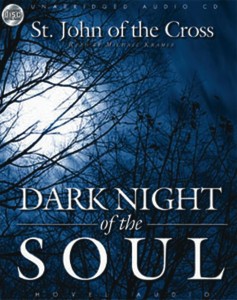Christian Contemplation in John of the Cross
In previous chapters I have already touched on John of the Cross. At this point I would like to develop what has already been said at greater length.
We must attune ourselves first to John’s terminology. John assumes that we start the life of prayer by discursive meditation on the gospel and on Christian doctrine. By prayerful reflection on the gospels we stir up in our hearts love of Jesus and of the virtues. Discursive meditation leads to affective and effective love. This is the beginning of one’s ‘mental prayer’. To some extent this kind of meditation will always be necessary so as to live in union with God in our daily lives. We cannot live without a certain amount of thinking.
However, after a certain time, perhaps a few years, the power to discursively reflect on Christian truths dries up in varying degrees, and a person can find thinking about God utterly fruitless during personal prayer. The initial first fervour can gradually dry up and the pray-ers may imagine that they are going backwards. They may find themselves in an arid desert. It seems to them that they are doing nothing and that they are no longer praying. But if people retain their total commitment to loving and serving God, this dryness, says John, is due to advance in the life of prayer.
The pray-er is blinded, says John, by the closeness of God, and is being called to remain simply in his presence in love. People in this state should remain still, making perhaps the occasional act of dry love. They must never force themselves to stir up feelings of devotion. They are being called to stay in stillness and simplicity with the Lord, making very few acts unless they are inspired to do so. De Sales, who says that he “prefers dry fruit”, recommends that ‘one’s acts be strained through the fine point of the will’.
Sitting still seems to pray-ers very much like idleness. It seems to them that they are doing nothing. Prayer seems to be one long distraction. Prayer seems to consist of dropping distractions and there seems to be very little relationship with God.
John of the Cross is not worried about how they feel provided they are totally committed to pleasing God inside and outside of prayer. John advises us to continue eating this unappetising food, assuring us that it is excellent prayer. We should not force ourselves back into discursive prayer but sit simply, loving the Lord. This sounds beautiful on paper but in practise it feels like a total waste of time. Sitting quietly, thinking of nothing, dropping distractions is very hard work, unless we have a technique for remaining still.
How Prevalent Is The Dark Night?
 Some form of Dark Night is widespread among those who take ‘mental prayer’ seriously. Most religious orders, founded in the last four or five hundred years, set aside in their daily timetable about one hour for mental prayer. Seminaries also recommend about an hour. It seems that the Jesuits and the Carmelites have drawn the church’s attention to the great value of such prayer. The present Code of Canon Law also prescribes ‘mental prayer’ for clerics and religious (C.C. 276 and 263).
Some form of Dark Night is widespread among those who take ‘mental prayer’ seriously. Most religious orders, founded in the last four or five hundred years, set aside in their daily timetable about one hour for mental prayer. Seminaries also recommend about an hour. It seems that the Jesuits and the Carmelites have drawn the church’s attention to the great value of such prayer. The present Code of Canon Law also prescribes ‘mental prayer’ for clerics and religious (C.C. 276 and 263).
Among those who faithfully practise mental prayer, some form of ‘Dark Night’ is very common. Let us give a few examples. “My prayer is usually nothing but distractions…I can tell you plainly…that for about 20 years God has taken away from me all power of any prayer of the understanding…that is meditation…” (Jane de Chantal, ‘Spiritual Life’ p. 148). She tells her nuns - “don’t say to priests, ‘I do nothing at meditation’ ….those who interfere little know what harm they do…it is enough to be with God in simplicity of heart” (ibid. p 173+). Fr. Thomas Green has written a book, ‘When the Well Runs Dry’. It is written out of his own experience and that of his clients. It is intended for people who cannot reflect in prayer and find it a dry arid experience. Nearly all John Chapman’s letters of spiritual direction are addressed to such people. De Caussade’s book, ‘On Prayer’, is also written for such people. Indeed in my view few people who continue in mental prayer for many years continue to use discursive meditation to any great extent. They just try to attend in love and simplicity to the Lord.
Recently I had contact with a group of third Order Carmelites, who are committed to a half-hour of mental prayer every day. Nearly all of them found their prayer arid, without feelings of devotion. One final example - “My profession retreat was like all the retreats that I have made since. It was a time of great dryness…it brought me no consolation, only complete dryness and a sense of desolation” (St. Therese, Autobiography, (Knox) p. 198).
As I said already, sitting in simplicity, loving God in dryness and making very few acts can be very hard work, unless we have a technique for remaining still. ‘Be still and know that I am God’ (Ps. 46).
How to Cope with Dryness
It is at this point that I think the Asian techniques for remaining still and coping with distractions can be very helpful. It is much easier to sit down, doing nothing in silent love, letting the Lord act, if we use the meditation techniques of John Main and Thomas Keating. They have integrated very successfully Asian techniques with Christian prayer, without sacrificing anything of their Christianity. They offer us methods for remaining still that are not difficult to practise. At times all of us will experience dryness if we persevere at regular mental prayer. Unfortunately many give up and abandon prayer when it becomes boring. Indeed the practise may be dying out in the modern church. What I am saying is that perseverance will be much easier if we adopt the methods of Main or Keating.
In conclusion many people, who practise mental prayer, often experience aridity, and have difficulty in persevering in an unappetising exercise. By adopting the methods of Main or Keating they would find it much easier to persevere in passive prayer. In a later article I will describe Main’s method in detail.

 Entries(RSS)
Entries(RSS)